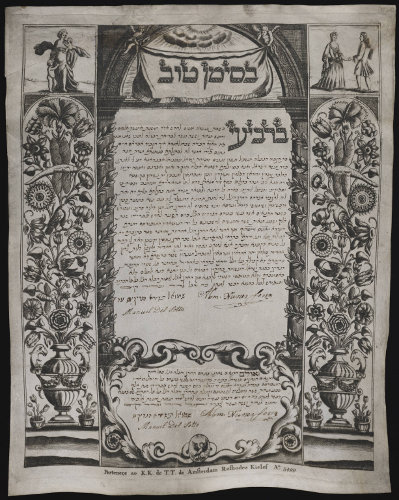
|
||
| Ketubot of the Sephardic Diaspora | ||
The Hague, Netherlands, 1756
Bride: Hannah bat Yisrael Imanuel Abendana
Groom: Avraham Hayim Nunes Fero
Wednesday, 10 Adar 5516 (February 11, 1756)
On vellum
The copper engraved frame that surrounds the text was quite common among Sephardic communities in Europe for several centuries. Though the text was written for a marriage that took place in The Hague, the border was printed in Amsterdam in 1739 (5499) as is stated at the very bottom of the document. The text is framed by a portal that is in turn enclosed by two large urns with large exotic flowers and birds emerging from them. Beside the urns are containers with tulips, the national flower of the Netherlands. The cherubs beneath the arch at the top hold a drapery inscribed with the statement be-siman tov (with a good sign). On the right side of the panel is an image representing the bridal couple and an image of a semi-nude woman with children is on the left. She is the allegorical representation of Caritas (Charity) and given the context, she is also probably a fertility symbol. The ketubah was signed by three witnesses, two of whom wrote their names in Latin characters. It is quite unusual for signatures on Jewish religious documents to appear in a language other than Hebrew.
